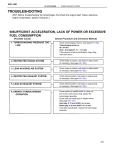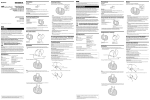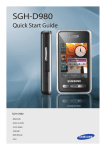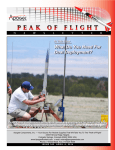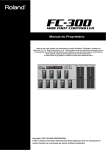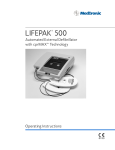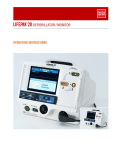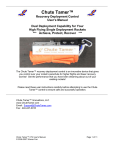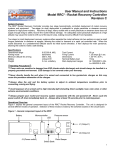Download PML Close Proximity Recovery CPR FAQ
Transcript
PMLCloseProximityRecoveryCPRFAQ.doc PML CLOSE PROXIMITY RECOVERY (CPR) FAQ 10/10/06 CPR – Close Proximity Recovery; PML exclusive system which deploys a small drogue chute at apogee to allow the rocket to descend quickly but stable, with the main chute(s) deploying at a user-selectable altitude AGL (above ground level). IMPORTANT NOTE TO HELP PREVENT BLOWBY DAMAGE: Through testing we’ve determined that customer complaints of black powder blowby is attributable in nearly every case to improper/incomplete prep of the charge cylinders. In all CPR prep instructions there is a step (usually Step C) that states: “Push a small wad of tissue into the hole using a pointed object. This will seal the hole and keep the black powder from leaking out.” In our tests we’ve determined that not performing this step completely is the #1 cause of BP blowby. The wad of tissue referenced must be packed tight and must fill the hole completely. Please take additional care in the future to check and recheck yourself on this important step. If our prep instructions are followed carefully and completely there is very little chance of any significant blowby. CPR3000 What is CPR? CPR is an altimeter based, two-step parachute deployment system. Using a dualdeployment altimeter, the first chute (a small drogue) is deployed at apogee allowing for a fast but controlled descent. At a user-selectable approximately 200, 400, 600 or 800 feet, (refers to PML Co-Pilot altimeter) the altimeter fires a second charge deploying the main chute allowing for a soft landing. The altimeter is centrally located in a special compartment within the main airframe. The drogue chute is ejected from a split-point in the airframe just above the fin/motor section while the main is ejected at the nose cone. Both chutes are deployed using our exclusive Piston Ejection System. Once assembled, the altimeter/charge cylinder assembly can be easily moved to another CPR3000 rocket, making it easy (and cost-effective, since you only need one altimeter) to fly CPR3000. CPR 2.1 and 2.6 come with a 12’ streamer (cut to desired length) instead of an 18” drogue chute, which comes with larger sizes. The chute is too large for these small diameters. A CPR-based rocket must always be flown with the electronics installed. A CPRbased rocket cannot be flown with motor-based ejection. This is because the fin section coupler/bulkplate assembly and the lower drogue piston block off the motor section from the rest of the rocket. 03/07/15 1/7 PMLCloseProximityRecoveryCPRFAQ.doc PML offers both CPR-Equipped kits, and CPR Retrofit Kits for converting an existing PML kit or scratchbuild rocket for CPR. See the CPR Systems page in our webstore for details, including a graphic showing what modifications are required to use CPR with many of our kits. What is CPR3000? The most complete Close Proximity Recovery System ever. No need to purchase separate ejection systems, external safety switch, or drogue chute. Also includes a 16 page, fully illustrated, comprehensive assembly and user manual. These systems are perfect for retro-fitting into your existing rockets or for incorporating into your new designs. Here’s what you get: Complete altimeter bay assembly. Complete Threaded Airframe Coupler assembly made from 6061 aluminum with a blue anodized finish. All mounting hardware for the PML Co-Pilot or Transolve P6 altimeter. Mounts for Transolve P4, P5, Adept ALTS-25, and BlackSky ALTACC altimeters sold separately) Two complete ejection systems including charge canisters and holders. (Designed for E-matches. Charge cylinders for flash bulbs sold separately.) One set of fore and aft altimeter O-rings provided, whether a CPR-based full rocket kit or a CPR Retrofit kit for scratchbuild use. Dual piston systems. Drogue chute (or streamer) with tubular nylon shock cord. External safety switch and lead wires. 16-page fully illustrated comprehensive assembly and user manual. See the CPR Systems page in our webstore for graphics and details. IMPORTANT NOTE ON ALTIMETER FIT IN ALTIMETER BAY: We’ve gotten reports of customers sometimes having difficulty getting the altimeter with O-rings fitted to slide into the altimeter bay properly. We’ve tested the fit of the CPR orings in the altimeter tube using both latest batches and older batches of parts. We’ve combined them in all combinations. In all cases the parts will NOT fit if no baby powder is used. With baby powder applied as per the CPR instructions provided with your CPRBased kit or CPR RetroFit Kit, all parts fit perfectly, seal well, and slide smoothly. MISCELLANEOUS CPR CUSTOMER QUESTIONS/INFORMATION Some customers have asked if the altimeter vent hole should be drilled through the airframe only (as our instructions tell you) or through the altimeter tube as well. The hole only needs to go through the airframe. The air passes through the airframe hole, works its way around the circumference of the altimeter tube and enters the altimeter bay through the large slot in the altimeter tube. Also, keeping 03/07/15 2/7 PMLCloseProximityRecoveryCPRFAQ.doc the AF vent hole on the opposite side of the slot, as the instructions direct, provides a buffer against tiny spikes in the airflow for better altimeter operation. Another question has been, “why is the drogue section of the rocket on the bottom and the main chute section on the top?” This is one of those questions where once you understand WHY, you will never forget the answer: Deploying the drogue from the nose could jerk the rocket enough to pull apart the lower section and deploy the main. Deploying the drogue from the middle doesn't jerk the nose away from the chute compartment. PML recommends that the fore and aft altimeter O-rings be used for only two flights, then thrown away and replaced with new O-rings. This will help ensure good sealing of the altimeter bay and protection of the altimeter from pressure spikes and black powder residue. We offer a 12-pack (6 fore, 6 aft) O-rings on the CPR3000 page of the webstore under part number CPR3K-OR-PK. One set of fore and aft altimeter O-rings is provided with the CPR3000 system initially, whether a CPR-based full rocket kit or a CPR Retrofit kit for scratchbuild use. “I ordered the charge cylinder for flash bulbs, but the flash bulb is very loose inside the charge cylinder.” Put a tissue "packing" around the flashbulb. Roll a small tissue square (preferably Estes wadding, since it's flameproof) about 1.5 x 1.5 into a tooth pick shape then form it into a ring and use a small screwdriver to pack it around the bulb once installed. Kind of like a tissue donut with the flashbulb in the "hole" of the donut. CPR3000 and Hybrids Using CPR3000 with a hybrid-based rocket is usually impractical, due to the excessive length that needs to be added to the rocket. CPR3000 requires nearly 3 feet to be added to a hybrid-based rocket, effectively putting it “out of bounds” for use with hybrid rockets. This is certainly true of PML’s hybrid-ready kits. CPR3000 Component Weights The following lists approximate weights (in ounces) for CPR3000 parts for use in RockSim or other simulation programs: 03/07/15 Aluminum Threaded Airframe Coupler 1.7 Aluminum Threaded Airframe Sleeve 0.6 Charge Holder 0.4 Charge Cylinder — Ematches 0.4 Charge Cylinder — Flashbulbs 0.6 Fore Altimeter Mount 0.6 Aft Altimeter Mount 0.3 3/7 PMLCloseProximityRecoveryCPRFAQ.doc Switch, 6 screws (4 alt, 2 sw.) & wiring 0.2 3 O-Rings 0.05 CPR-MAX CPR-MAX = CPR3000 for Large-Diameter Rockets Our CPR system has been available in 2.1 through 3.9" diameter sizes for years. Our new CPR-MAX system was developed for 6” and 7.5” rockets. This system allows for redundant recovery system deployment for the purpose of safety and to protect your investment. If you`ve always wanted to add CPR3000-style recovery to your 6.0 or 7.5 inch kit, CPR-MAX is the answer! The CPR-MAX system uses the same components as the CPR3000 system, but in a special design configured for large-diameter 6- and 7.5-inch airframes. CPRMAX also features twin-altimeter design, which can be used either as the backup required for Level 3 flights or as a safety backup for regular sport flying. NOTE: CPR-MAX does not REQUIRE the use of two altimeters. It can safely and effectively be flown with only one. The second altimeter is a redundancy feature, not a requirement. The CPR-MAX System contains nearly everything you need (altimeters, epoxy, ejection powder, and additional airframes, if required, not included) to convert your existing rocket or as an enhancement to your own design. The Bulldog, AGM-600 and Pterodactyl kits would require over 2 feet of airframe tubing to be added to use the CPR-MAX system, which would change their appearance so substantially that PML does not recommend CPR-MAX for these kits. The information below is intended as a guide for determining the proper amount of ejection powder used with various diameter CPR-MAX rockets using a piston ejection system and a 24” fore or aft recovery airframe: o 6.0” diameter – 1.0 to 1.3 grams o 7.5” diameter – 1.2 to 1.5 grams CPR-MAX Component Weights The following lists approximate weights (in ounces) for CPR-MAX parts for use in RockSim or other simulation programs. This does NOT include the weight of the pistons, KwikLinks, or piston straps, only the “core components” of the CPR-MAX system. The weight is for one part, so if more than one is used be sure to multiply the weight by the quantity of parts: COMPONENT 03/07/15 QTY. 6.0 7.5 CT-6.0 1 10.75 15.75 CT-6.0x8” 1 6.9 10.2 4/7 PMLCloseProximityRecoveryCPRFAQ.doc CT-6.0x1.5” 2 1.3 1.9 PT-6.0x2” 1 1.5 2.3 Aluminum Threaded Airframe Coupler 2 1.7 1.7 Aluminum Threaded Airframe Sleeve 2 0.6 0.6 PT-1.5x10” 2 1.7 1.7 Birch Bulkheads/Mounting Plates 2 3.65 3.95 Charge Caps, Vinyl 4 0.05 0.05 Charge Holder 4 0.4 0.4 Charge Cylinder — Ematches 4 0.4 0.4 Fore Altimeter Mount 2 0.6 0.6 Aft Altimeter Mount 2 0.3 0.3 Switch, 6 screws (4 alt, 2 sw.) & wiring 2 0.2 0.2 O-Rings 6 0.05 0.05 CPR2000 CPR2000 is designed to use the Transolve P4 or P5 altimeter or the Adept ALTS25. We do not currently offer adapters to use electronics from other manufacturers. CPR2000 components are still available on our webstore for customers who may own CPR2000 kits and need replacement parts. Differences in Mounts for CPR2000 and CPR3000 The mounts for the CPR3000 (for Co-Pilot and P5 or P6) are just more robust. Basically the areas where the holes are located are thicker. If you tried to mount a Co-Pilot to a 2000 mount, not only would the holes not line up but also there’s more room than needed to clear the parts on the altimeter. On the other hand, if you tried to mount an ALTS2 to a 3000 mount, the holes would not line up and there would be interference between the mount and components on the altimeter. PML Co-Pilot Altimeter for CPR3000 (See the Electronics page of our webstore for more details on each device and other devices that may not be covered here). 03/07/15 5/7 PMLCloseProximityRecoveryCPRFAQ.doc PML currently carries the PML Co-Pilot altimeter. The Co-Pilot altimeter was developed exclusively for Public Missiles Ltd. by Missile Works Corp., and was designed specifically for PML’s CPR3000 Recovery System (though it can also be used in other applications as well, such as scratch-built deployment systems). The Co-Pilot is based upon Missile Works’ RRC2 altimeter. The Co-Pilot provides two-stage barometricallycontrolled (pressure-sensing) deployment of rocket recovery systems and equipment. Note Regarding CPR3000 and Altimeter Manufacturers Some customers have asked why we chose to select the PML Co-Pilot and Transolve P6 as the standard altimeters that fit CPR3000, and the Transolve P4 or P5, Adept ALTS-25, and BlackSky ALTACC altimeters with our optional additional-cost adapters. First, we believe very strongly in supporting our customers. PML has sold hundreds of CPR2000 kits that use the Transolve P4 or P5 or Adept ALTS-25 altimeter (and many of those altimeters to go with the kits as well). We want our current customers to have complete compatibility immediately. It makes sense for us and for them to use an altimeter they're already familiar with and is interchangeable between their current CPR2000 rockets and any CPR3000 systems they may choose to buy. Second, the better question might be "How come the altimeter manufacturers don't make theirs fit CPR?" We're the only company that offers a standardized "ready out-of-thebox" dual deployment system, and we have over a thousand of these systems in the hands of rocketeers, so it would make sense for the altimeter manufacturer to make their product fit the rocketry system that's most likely to use their product, wouldn't it? In our opinion, it would make sense for the altimeter manufacturers to base their designs around fitting CPR, and the scratchbuilders not using CPR can design mounting schemes for their altimeters as they always have. We're in the rocket business, not the altimeter business, so we leave the altimeter issues to those that make them. Third, as you know there are many different sizes and shapes of altimeters available, and it simply wouldn't be cost-effective for us to produce all the altimeter mounts to fit each and every altimeter someone might like to use since we'd sell very few of any particular adapter, not enough to offset the tooling cost of the adapter. It makes much more sense for the altimeter manufacturers to either a) offer a version of their product ready-made to fit CPR systems, or b) make altimeter mounts to fit CPR and sell them to promote use of their altimeters. It's in their best interests to do either a) or b) to sell more of their altimeters, and to support their customer base (as we are with making CPR3000 compatible with what our customers already own. Our CPR3000 altimeter bay is already designed in anticipation of altimeter manufacturers "picking up the ball" by designing it long enough and wide enough to accommodate any altimeter on the market at the time of it’s introduction. BlackSky has done so by making an adapter available for their ALTACC line of altimeters, which we now sell as well. 03/07/15 6/7 PMLCloseProximityRecoveryCPRFAQ.doc So, to summarize, we strongly believe in supporting our previous customers, and would expect that the altimeter manufacturers can and should do the same by making their products work with CPR, either through the base design or through offering CPRcompatible mounts for their products. BlackSky AltAcc Adapter; Modifying AltAcc to work with CPR3000 PML now sells a BlackSky ALTACC adapter to fit all ALTACC models up to and including the 2C, the CPR3K-ALTACC-ADPTR, which is available on the CPR Systems Page of the PML website. If you have any questions about using the ALTACC with CPR3000, contact BlackSky. If you have an older ALTACC with a green board, 1/16" has to be sanded off each end of the board for the CPR3K-ALTACC-ADPTR brackets to fit. Prior to the availability of the adapter some customers modified the CPR3000 mounts to fit the ALTACC. The following information about modifying the mounts for ALTACC is from a PML customer. We can neither confirm nor deny that it works, but provide it to you here for your reference. +++ “I called and talked to Scott at Blacksky and he stated that all you had to do was cut or file four notches in the edge of the circuit board were the screws for the CPR mounting would engage and hold the altimeter in place. The copilot altimeter has holes in the circuit board, but the AltAcc has 2 metal standoffs that normally hold it to the body tube. I took a triangular file and made 4 small notches to hold the altimeter to the CPR module. The Alt Acc uses a jumper to turn the unit on & off. The system is normally armed by closing a screw on the circuit board (again via another hole in the airframe) and the status of the unit is determined by looking at a LED on the circuit board via a hole in the airframe. I went a couple of steps further and wired the jumper block (on/off jumper) tothe CPR switch mounted on the body tube. This allows the AltAcc to be armed without accessing the altimeter directly. I also drilled another hole in the altimeter bay, so I could view the LED indicator, to determine the status of the altimeter.” +++ 03/07/15 7/7








